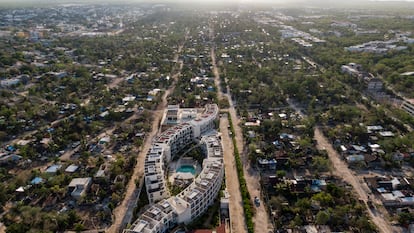The poverty that Tulum’s tourism boom cannot hide
The Mexican municipality registered the highest increase in poverty in the country, according to the most recent data. Thousands live in illegal settlements amidst hotels and luxury condominiums

A thin dirt road divides a luxury real estate development from the 2 de Octubre neighborhood in Tulum. On one side, workers are building apartments with modern glass finishes, beige walls and turquoise pools. At the end of the day, they cross the road to their homes, dirt-floored shacks without walls, drainage or running water. The scene has become ubiquitous throughout the town where well-heeled tourists ride Vespa motorcycles past illegal settlements where thousands live in poverty.
Tulum, the new jewel of the Riviera Maya, is the municipality where poverty has increased the most in recent years in the country, according to the most recent data from Mexico’s National Council for the Evaluation of Social Development Policy (CONEVAL). The rate went from 32% in 2015 to 62% in 2020. The increase is linked to high rates of migration from poorer states. As a result of the tourism boom, people from Veracruz, Tabasco and Chiapas, among others, have been coming to Tulum in growing numbers to find work. According to the National Institute of Geography and Statistics (INEGI), the state of Quintana Roo, where Tulum is located, has a population growth rate of 3.5%, the highest in the country.
The 2 de Octubre neighborhood is not recognized by the authorities. It is named after the date in 2016 when its residents took the land in the center of the city by force, says Jessica, an inhabitant of the settlement who asked to withhold her last name for fear of retaliation. Originally from the center of the country, the mother of three came to Tulum after fleeing organized crime in Playa del Carmen.
“We had a store there, but protection money became a problem,” says Jessica, 33. “There came a day when, as they were extorting us, the cartel demanded that we leave. At that time, people were having a meeting to organize themselves to come here, on this land, and we came here.” Jessica and her husband live in the settlement, where they set up a grocery store to cater to their neighbors, most of whom are hotel, restaurant, condominium and construction workers. Despite the investment that those businesses bring in, the jobs are informal.
Illegal settlements
To access electricity, the residents hang improvised devices that connect to the fuse boxes of nearby neighborhoods that do have electricity. They draw water with pumps from a well they dug themselves, and they bathe in a nearby cenote, where families also spend time. 2 de Octubre was the first neighborhood of its kind. It was followed by at least two others that were originally miles away from the hotel zone. Today, all of the neighborhoods have been surrounded by real estate development.
“When we got here, there was no one. It was like a ghost town,” says Jessica, as she sells a kilo of tortillas to a neighbor. “There were a few palapas, but little by little people started taking over the lots and building more palapas. When there are roofs, people who want to work start arriving. Up to 15 people live inside one single palapa. And they will keep coming.”
Not even the pandemic slowed the growth in Tulum. From 2019 to date, jobs registered with social security have increased by 74%, according to data compiled by the Government of Quintana Roo. The growth of the coastal city has been rapid and, due to the absence of an urban development plan, chaotic. Luxury apartments and condominiums are being built, but there are not enough homes for workers. There are a few opportunities for subsidized low-income housing, but workers making between 5,000 and 5,600 pesos a month, without benefits because of the work’s informal nature, cannot afford them.
For large companies that build hotels and vacation homes in this part of the country, both foreign and national, Tulum’s appeal lies in the low price of labor, says Salvador Ramos, founder of the Quintana Roo College of Economists and a professor at the state’s Autonomous University, UQRoo. “Who are the big winners? The winners are the owners,” the specialist says over the phone. “Some time ago, a study was done that concluded that for every dollar generated, investors take 0.80 and only 0.20 remains in the population,” he says. “Life is very expensive, housing is very expensive and jobs are very poorly paid. That is why we have this problem.”
According to local media, the municipality reported in September that between 5,000 and 6,000 people live in this type of settlement in Tulum. The number represents just under 10% of the population. However, municipal authorities told EL PAÍS that they do not keep a record. It is difficult to know precisely how many people live in the irregular neighborhoods, since, according to the neighbors, more arrive every day.
Internal migration
María López, 29, arrived in Tulum from Chiapas three weeks ago. Her husband, Pedro, already worked in the seaside town. The couple has four children between the ages of 5 and 10, who, like their mother, speak little Spanish, since their native tongue is Tseltal. After being separated for years, the family decided to rent a one-room house in one of the “invasions,” as illegal settlements are known. The walls are made of cement blocks, the roof is made of tin and the floor is dirt. The fan’s hum mixes with the dialogue of the soap opera on television, which sits next to a refrigerator and in front of the family’s shared bed. To live there, they pay more than 1,000 pesos a month to the person who took over the piece of land in 2016.
“I like it here,” says María, while playing with her youngest son, Eric, on the bed. “In Chiapas there is nothing, there is no work, there is no money.” She knows how to write because her brother taught her, but she has no math skills because she never went to school. This limits her job opportunities in a city where tourist services represent a large part of the labor market. But María moved to Tulum to work too, she says, because everything went up in price, and now a single income is not enough. Inflation in Mexico is close to 8%, levels not seen in 20 years. Her children do not go to school and are waiting for the arrival of Maria’s cousin, who will take care of them while her mother works.
The kids play with a deflated ball outside under the shade of a leaky roof. Throughout the neighborhood, plastic bottles and bags pile up in front of shacks and on street corners. An ice cream vendor passes by on his motorcycle advertising his products. A few blocks away, two advertisements adorn the main road: one offering land for sale near the sea and the other, in English, offering temazcales and spiritual healing rituals.
In the development in front of 2 de Octubre, only a few apartments are available. Although construction has yet to be completed, almost all of them have already been sold, according to an employee. The complex offers a gym, spa and yoga classes and welcomes both foreigners and domestic tourists. Prices are around $300,000 per unit, and owners can sublet or list them on Airbnb. When asked about the illegal settlement just across the street, the employee replies: “We don’t have a plan to build on that land and we’re not sure [what will happen]. According to the Government they are going to move them,” he says, “but we are used to it and the people there are easy-going. We don’t have any problem with them.”
Carlos Salas, the municipality’s Director of Urban Development, said in a telephone interview that there is no plan to regularize or move the residents of the illegal settlements, since a lawsuit by the land’s private owners is pending resolution. “There is a problem there between individuals, the invaders and the owners of the land. There are trials and pending sentences. We cannot enter or make any decision until that lawsuit is concluded,” says Salas. Nor is there a plan to offer housing to the thousands of workers who come to the municipality from other places, he admits. The mayor did not respond to interview requests.
Meanwhile, Jessica lives in fear of eviction or losing access to the electricity that allows her to run a business and earn an income. “They treat us like we are below them,” says the vendor. “They look down on us, they accuse us of being thieves, but we’re not. We came here to make a living.”
Tu suscripción se está usando en otro dispositivo
¿Quieres añadir otro usuario a tu suscripción?
Si continúas leyendo en este dispositivo, no se podrá leer en el otro.
FlechaTu suscripción se está usando en otro dispositivo y solo puedes acceder a EL PAÍS desde un dispositivo a la vez.
Si quieres compartir tu cuenta, cambia tu suscripción a la modalidad Premium, así podrás añadir otro usuario. Cada uno accederá con su propia cuenta de email, lo que os permitirá personalizar vuestra experiencia en EL PAÍS.
¿Tienes una suscripción de empresa? Accede aquí para contratar más cuentas.
En el caso de no saber quién está usando tu cuenta, te recomendamos cambiar tu contraseña aquí.
Si decides continuar compartiendo tu cuenta, este mensaje se mostrará en tu dispositivo y en el de la otra persona que está usando tu cuenta de forma indefinida, afectando a tu experiencia de lectura. Puedes consultar aquí los términos y condiciones de la suscripción digital.
More information
Últimas noticias
Most viewed
- Reinhard Genzel, Nobel laureate in physics: ‘One-minute videos will never give you the truth’
- Oona Chaplin: ‘I told James Cameron that I was living in a treehouse and starting a permaculture project with a friend’
- Pablo Escobar’s hippos: A serious environmental problem, 40 years on
- Chevy Chase, the beloved comedian who was a monster off camera: ‘Not everyone hated him, just the people who’ve worked with him’
- Why we lost the habit of sleeping in two segments and how that changed our sense of time











































